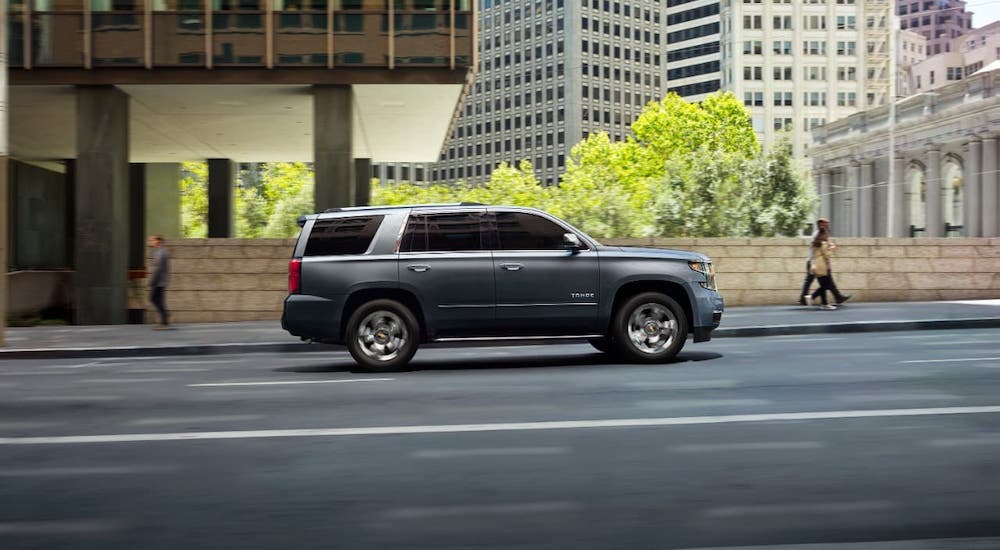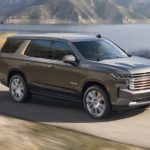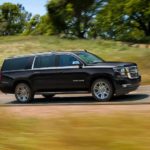For years, Toyota has been the brand known for its exceptional value, so you might not be surprised to find that the Chevy Tahoe is many experts’ pick for the best value in a large SUV. With fantastic performance, even better prices, and packages that do not disappoint, the Tahoe offers so much more than its competitors. But how exactly does the praised SUV stand up against the others in its segment? To find out, let’s take a closer look for ourselves and make a comparison: 2020 Chevy Tahoe vs 2020 Toyota Sequoia.
This shouldn’t come as much of a surprise when you really think about it, but: Chevy has been making big SUVs and trucks for some time now while Toyota has mostly stayed away from these markets. The Sequoia is the largest SUV in Toyota’s lineup, and they do not make a mass-market truck larger than the half-ton Tundra. Chevy specializes in big trucks and big SUVs. It’s one of the things Chevy does really well. So, what exactly gives the Tahoe more inherent value than all of its competitors? One of the things you need to have in a big SUV or truck is a good powertrain—a strong engine and refined transmission—and Chevy understands this better than Toyota. So let’s take a look at what each Chevy and Toyota have to offer.
Comparing the Power Source
The 2020 Chevy Tahoe features two engine options, and both are powerful and efficient. Unfortunately, the 2020 Toyota Sequoia has only one engine option, and it’s paired with an aging transmission, and there’s nothing efficient about this powertrain. That’s unfortunate because that’s where most of the value lies in a full-size SUV. You want your sport-utility vehicle to be able to tow the boat to the lake, hit the open road with a travel trailer, and handle carpooling and commuting with similar ease.
To start, the 2020 Tahoe can tow up to 8,600 pounds with either of its two powertrains. The standard engine is a 5.3-liter V8 with 355 hp and 383 lb-ft of torque. This engine features a high-tech fuel injection system to enhance both efficiency and power, as well as GM’s Active Cylinder Management, which can shut down half the cylinders when not needed to help preserve fuel. With this setup, you can expect to return 15 MPG in the city and 22 MPG on the highway. If you need more power than the standard 5.3-liter V8, the 2020 Chevy Tahoe also has an optional 6.2-liter V8 with 420 hp and 460 lb-ft of torque. With more horses and much more low-end muscle, this is the sort of engine you expect from a full-size SUV. There is a decrease in fuel economy with this setup, though, at 12 MPG in the city and 21 MPG on the highway.
On the other hand, the 2020 Toyota Sequoia’s lone powertrain is a 5.7-liter V8 with 381 hp and 401 lb-ft of torque. This is a powerful engine, and if mated with a better transmission, this could be an interesting option, but the Sequoia finds itself in need of a refresh. It’s almost as if Toyota doesn’t know what they’re doing with the six-speed offering. In the essential areas of towing, horsepower, and fuel economy, the Sequoia doesn’t just fall short; it fails miserably, lagging way behind the competition. The Sequoia’s fuel efficiency rivals that of a one-ton truck, however, with a rating of only 13 MPG on city streets. You can live with this kind of inefficiency if your rig can tow your house, but when it can only tow 7,400 pounds, that’s a problem. So, not only can you tow more in the Tahoe, but you can also make it to the next gas station easier.
This significant difference between the two vehicles is not existent just because the Sequoia is not good; it’s there because the Tahoe keeps getting better. The fifth-generation Tahoe, due out for the 2021 model year, offers magnetic ride control or air suspension, and a diesel engine with an excellent blend of torque and fuel efficiency. So the gap between the two is growing and leaving the Sequoia even further behind. And with all of this, it is evident that Chevy understands this segment better than Toyota.
What You Pay For
You might expect that with such a discrepancy in power and efficiency numbers, the Sequoia must be more affordable, that its starting price must reflect its aging powertrain. That’s not the case, though, as the 2020 Toyota Sequoia starts at $49,980 while the 2020 Chevy Tahoe starts at $49,000. So, with the Tahoe, you can afford one more vacation than with the Sequoia or much more optional equipment. In fact, this gives drivers the financial room to move up to the second trim, the LT, that will offer more features and a greater experience.
And the LT trim is a good place to find yourself. Standard features at this trim level include forward-collision alert, low-speed forward emergency braking, lane-departure warning, a Bose premium audio system, and leather seating. The LT trim also features optional equipment like 2nd-row bucket seats and a sunroof. There’s also a rear-seat entertainment system, with a Blu-ray player and wireless headphones, for the kids. So you can see why this full-size SUV is a good value, or to be more precise— the best value in its class.
How does the Sequoia compare in terms of standard equipment? It keeps pace with the Tahoe in this department, but in the end, it’s not enough to overcome its flawed powertrain and higher prices.
Z71 vs TRD Pro
With both auto manufacturers known for their off-road engineering, it would be impossible to compare these two SUVs without discussing their off-road models. The Tahoe brings Chevy’s Z71 off-road package while the Sequoia offers its TRD Pro trim. With the 2020 Chevy Tahoe, you’ll find an upgraded suspension, Z71-specific skid plates, hill-descent control, as well as an upgraded 3.42 rear axle, transfer case, and a high-capacity air cleaner for the dusty trails. The 2020 Toyota Sequoia features a TRD-tuned suspension, Fox off-road shocks, and skid-plate protection.
Both the Tahoe and Sequoia feature robust off-road packages, so it’s hard to make a case for one being better than the other. You’ll find what separates them is not so much their off-road ability, as both are capable off the pavement, but the aesthetic exterior upgrades of the Tahoe. The Tahoe looks the part. It’s Z71-specific grille design, fog lamps, black assist steps, black recovery hooks, and Z71 badging on the pillar and liftgate, mean the Tahoe looks like it belongs where roads give way to trails.
An Easy Decision
When it comes down to choosing a large SUV, it’s easy to see why the Tahoe’s resale value is so strong—and why its current generation was recognized for its great value. The 2020 Chevy Tahoe offers everything you want from a full-size SUV: power and efficiency and refinement. And with a spacious interior loaded with family-friendly tech, the 2020 Chevy Tahoe makes this decision easy. This is the perfect SUV for your family, with much more value than Toyota’s full-size offering—more value than any other manufacturer’s full-size offering, in fact.






